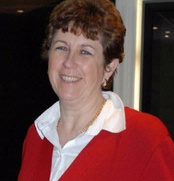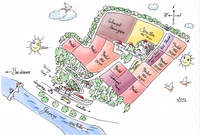|
|
 |
.jpg)
The wine business in Bordeaux has been traditionally male dominated, but as in many businesses throughout the world, women are playing a bigger role. Or, maybe it is just that they are finally getting recognition for the role they have played all along. In any case, I met many very talented and forceful women during a recent visit courtesy of the Bordeaux Wine Council. I’d like to introduce you to three women who did not start out in the wine business, but now find themselves fully immersed and evidently loving every minute of their work.
Marie-Hélène Lévêque, Château de Chantegrive
Marie-Hélène Lévêque, is Director General of Château de Chantegrive in Podensac. Her parents, Henri & Françoise Lévêque, acquired two hectares (4.9 acres) of property in Graves in 1966 with the funds they received from selling what must have been an amazing stamp collection. Over time the family added plots with the latest acquisition of 14 hectares (34.6 acres) of  old Semillon in 2014. Today the property is one of the largest in the appellation with 96 hectares (237 acres) in production. old Semillon in 2014. Today the property is one of the largest in the appellation with 96 hectares (237 acres) in production.
Marie-Hélène was a nurse before she became involved in the family’s wine project. She worked in the business for several years, and then became the director in 2006. At that time, she enlisted Hubert de Boüard, owner of Château Angelus (and Hubert de Boüard Consulting), to help her improve the quality of their wines. She is clearly doing something right, because she was named Bordeaux winemaker of 2018 by Guide Hachette des Vins.
She has worked to make the estate more environmentally sustainable, creating a waste-water treatment plant and adding cover crops in the vineyards to increase microbial activity and improve soil structure. In 2015 the estate received ISO (International Standards Organization) 14001 certification, which is “an internationally agreed standard that sets out the requirements for an environmental management system (EMS). It helps organizations improve their environmental performance through more efficient use of resources and reduction of waste.”
A tasting with Marie-Hélène focused on the estate’s white wines, which account for 25 percent of their production. She clearly delighted in sharing .jpg) current and older vintages to give us a sense of how well they age. The 2015 Château de Chantegrive, Graves ($20, imported by Millesima) had captivating floral aromas with grapefruit, melon flavors smoothly integrated with piquant acidity that builds to a lingering finish. The barrel fermented Cuvée Caroline 2014 ($26), was richer and round with ripe pear aromas and flavors with floral notes, an intense, lush and lovely wine. We tasted a 2007, which had the intensity and richness of the 2014, but the aromas were more cardamom spice than fruit. It was glorious. current and older vintages to give us a sense of how well they age. The 2015 Château de Chantegrive, Graves ($20, imported by Millesima) had captivating floral aromas with grapefruit, melon flavors smoothly integrated with piquant acidity that builds to a lingering finish. The barrel fermented Cuvée Caroline 2014 ($26), was richer and round with ripe pear aromas and flavors with floral notes, an intense, lush and lovely wine. We tasted a 2007, which had the intensity and richness of the 2014, but the aromas were more cardamom spice than fruit. It was glorious.
Youmna Asseily, Château Biac
When we arrived at Château Biac, Youmna Asseily, an amiable force of nature, was draining yogurt to make labneh, the soft cream cheese of .jpg) Lebanon. Youmna and her husband, Tony, are from that country, but they moved to London because of the war. They vacationed in France and discovered Biac when they rented a guesthouse. They fell in love with the location, and, over time were able to convince a reluctant owner to sell it to them. Lebanon. Youmna and her husband, Tony, are from that country, but they moved to London because of the war. They vacationed in France and discovered Biac when they rented a guesthouse. They fell in love with the location, and, over time were able to convince a reluctant owner to sell it to them.
They had no experience with vineyards or winemaking. Tony was a banker who loved and collected wine. They spent nine years reconstructing buildings and vineyards from top to bottom. It is a property with a long history, likely dating back to the Romans, and they wanted to respect that legacy. They have an all-star team of expert help from Christine Sourdes (oenologist to Château Guiraud and Château de Myratand) for sweet whites; Patrick Leon, former managing director of Mouton Rothschild for the red wines, and Gilles Rey, Leon’s collaborating agricultural engineer for the vineyards.
They also have a property with diverse soils of gravel, clay-limestone, silt and sand that lay upon a layer of chalk. As Youmna puts it, “On a very small estate, we have the soils of both the Right and Left Bank.” In addition to the unique soils, the vineyard’s aspect and slope allow the air to flow through the vines and along with the presence of Garonne River help to moderate temperatures, providing frost protection.
We tasted B de Biac Cotes de Bordeaux Cadillac AOC 2012 ($27, Misa Imports), which is a blend of near equal parts Merlot and Cabernet .jpg) Sauvignon. It was drinking very well with ripe black fruit flavors and solid, ripe tannins. Château Biac, Côtes de Bordeaux-Cadillac AOC 2012 ($50) is predominately Merlot, with half as much Cabernet Sauvignon, then half as much Petit Verdot finishing with a touch of Cabernet Franc. It was a rich, concentrated wine with spicy as well as floral notes finishing with ripe, but husky tannins that need time to mellow. Sauvignon. It was drinking very well with ripe black fruit flavors and solid, ripe tannins. Château Biac, Côtes de Bordeaux-Cadillac AOC 2012 ($50) is predominately Merlot, with half as much Cabernet Sauvignon, then half as much Petit Verdot finishing with a touch of Cabernet Franc. It was a rich, concentrated wine with spicy as well as floral notes finishing with ripe, but husky tannins that need time to mellow.
We finished with Secret de Château Biac, Cadillac AOC 2012 (2011 is $53 for 500ml), which is made with botrytized grapes, almost all Semillon, but with one percent Sauvignon Blanc. Dried apricots, spiced with cinnamon were delicately balanced with vibrant acidity. Youmna brought out a savory baked pear-cheese dish that proved you really shouldn’t serve sweet food with what is dismissively considered by some to be a “dessert wine.”
Françoise Lannoye, Vignobles Lannoye
Françoise Lannoye of Vignobles Lannoye is a dynamo. She was working with her husband in a very successful construction business when she decided she wanted to make wine. Her family’s business was farming, so  perhaps it was not so big a leap for her, but leap she did. You might imagine that with such a big career change, one winery would be plenty. Not Françoise. She now has three different estates in three different appellations, Château Moulin de Clotte in Castillon – Cotes de Bordeaux, Château Lanbersac in Puisseguin Saint-Emilion, and Château Ambe Tour Pourret in Saint-Emilion. perhaps it was not so big a leap for her, but leap she did. You might imagine that with such a big career change, one winery would be plenty. Not Françoise. She now has three different estates in three different appellations, Château Moulin de Clotte in Castillon – Cotes de Bordeaux, Château Lanbersac in Puisseguin Saint-Emilion, and Château Ambe Tour Pourret in Saint-Emilion.
Additionally, she is not afraid to take risks with such tricky endeavors as a no-sulfite-added wine. I--for one--am not sulfite-averse, and have a healthy respect for the role of SO2 as part of the winemaking process. However, that doesn’t mean I can’t enjoy a well-executed, delicious, 100  percent Merlot like Françoise’s Castillon – Cotes de Bordeaux AOC, L’Authentique 2016 ($19 Michel Thibaut Wine) from her Château Moulin de Clotte estate. It was a very fresh, juicy and lively wine with rich blackberry and raspberry fruit balanced with zesty acidity and ripe tannins. percent Merlot like Françoise’s Castillon – Cotes de Bordeaux AOC, L’Authentique 2016 ($19 Michel Thibaut Wine) from her Château Moulin de Clotte estate. It was a very fresh, juicy and lively wine with rich blackberry and raspberry fruit balanced with zesty acidity and ripe tannins.
Françoise noted that her aim was to keep the Merlot grape’s pure fruit flavors, but not adding SO2 requires extreme vigilance. “You have to be careful at every step. There is no leeway. The wine cannot wait at any step.” She also revealed that if the market demand increases for no-added-sulfite wines, she may well make more wines like this. “You must always have something new to offer consumers.”
A more classical Merlot from 35-year-old vines is Francois’s Château Lanbersac, Puisseguin Saint-Emilion AOC, Cuvee Vieilles Vignes 2014 ($40). It showed spicy, ripe, dark fruit nicely integrated with buoyant acidity and dusty tannins.
* * *
As I noted at the outset, these three women evidently love their work, and you are likely to love the fruits of their labors.
|
 |
|